This was published 5 years ago
How class divisions evolved in planes: The evolution of cabins through the decades
By Michael Gebicki
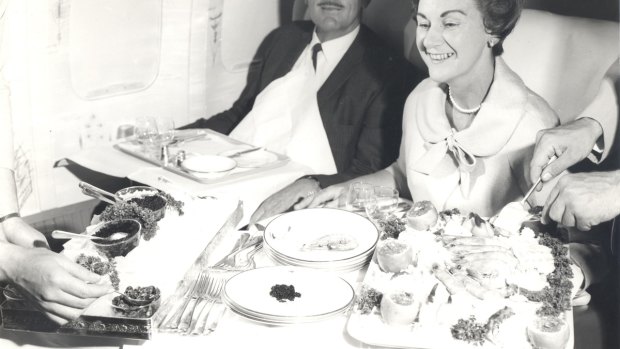
A first class meal on Qantas inn 1966.Credit: Qantas
Once upon a time, when pilots wore sheepskin-trimmed leather jackets, there were no class divisions in passenger aircraft. Everyone lounged about on armchairs, in the same cabin. Chaps wore suits, women wore dresses and packed slinky pyjamas because on a long flight you got to sleep flat out, on a train-style double decker bunk bed. There was no business class, no first – but there didn't need to be. Cabins were small and the mere fact that you were sitting in an aircraft being flown somewhere conveyed wealth and privilege. In 1935, when Qantas began flying passengers from Brisbane to Singapore to connect with the Imperial Airways' flight to London, the return fare for the entire trip was £486 in Australian currency. At that time, the average annual wage for a manager in Victoria was £364.
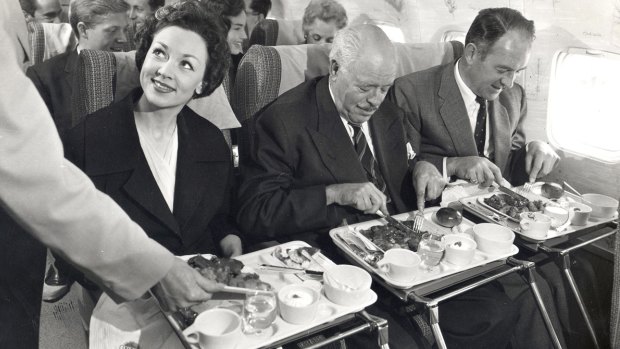
Credit: Qantas
The dawn of mass air travel
In the postwar era, airlines found a use for passenger versions of the bigger, faster aircraft that had been developed for the war effort and these became the precursors to a new era of flying. The aviation industry was booming, especially in the US. Airlines were also realising that their future lay in catering to the masses, and that meant packing more bodies into fuselages. Those cheaper seats were known as coach class, what the rest of the world would come to call economy. Even though coach class first appeared in the 1940s, for many years it remained a less popular option. In the USA, not until 1961 did the number of passenger miles flown by coach-class passengers exceed those flown by first-class travellers.
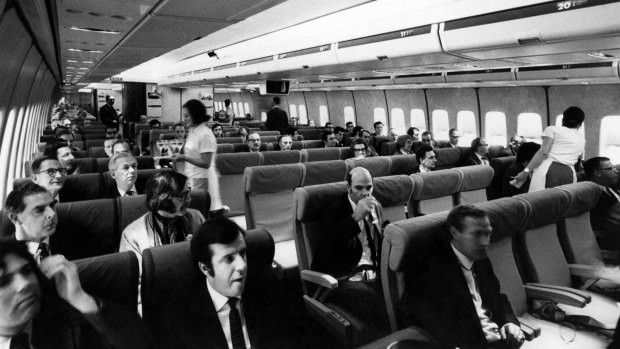
Credit: Alamy
Aircraft became bigger and faster with the dawn of the jet age in the 1950s but the classes stayed the same except that the divide between economy and first class widened, both in comfort and fares. While the difference between first and economy class was initially quite modest, and the first-class fare was only about 50 per cent more, by the 1970s the difference was huge, and so was the fare. This was also the era when the Boeing 747 had become the dominant aircraft for long-distance travel, and they rarely flew at full capacity. The 747 gave airlines more space to think creatively – remember those piano bars and upper-deck lounges – and also the opportunity to create a bridging class. In the late 1970s business class was born, which quickly became the seat of choice for professional and upper-leisure travellers looking for greater comfort than economy without the high price tag of first class.
The business class boom
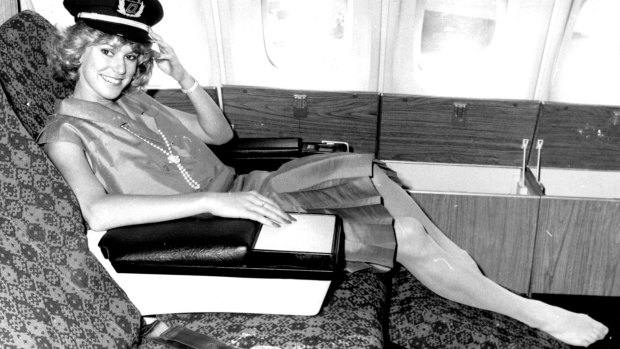
Credit: Peter John Moxham
Business class found an immediate foothold in the market and hasn't looked back. For the well-heeled passenger it offered a far better inflight experience, with greater comfort, better food, status recognition and enhanced personal service.
For the airlines as well, there was plenty to like. Across the industry, business travellers account for 12 per cent of passengers but typically generate twice that figure in airline revenue. As airlines look to increase their share of this lucrative market sector they have ratcheted up their business class cabins to the point where a first class of the year 2000 would be a pale shadow of today's business class seat on a leading international carrier.
All the major carriers now pamper their business class flyers with lie-flat seats, privacy screens, menus curated by name chefs, big entertainment screens and noise-cancelling headphones, ritzy lounges and a swag of minor perks that confirm the flyers membership of an elite club. To cut it among the leading carriers, a business class seat must now have privacy screens that create a virtual one-person enclave. For a couple travelling together, side-by-side business seats that fold down to make a double bed is a realistic expectation aboard leading carriers.
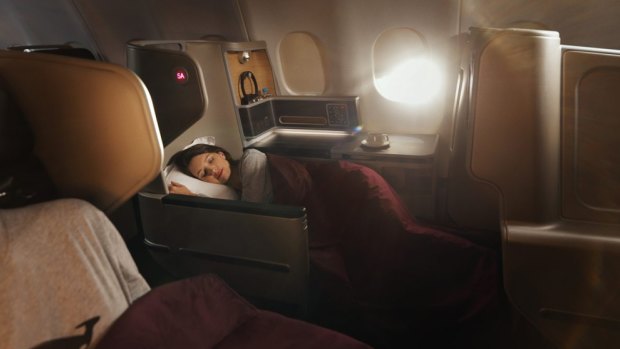
Although nobody would have picked it at the time, business class also signed the death warrant for first class. Only a small number of the world's airlines offer a first-class service these days. Why pay $15,000 or more for a first-class return flight from Australia to London when you can pay just half as much for a seat in business?
Chopping up economy class
The aircraft cabin was segmented once again when premium economy class came into view, first with EVA Air, in 1992, which introduced a new class called economy deluxe on its Boeing 747 flights between Taipei and Los Angeles. Offering a seat with better leg room, greater width, slightly greater recline angle, a separate cabin and a menu that bridges the gap between business and economy, premium economy has found fairly wide acceptance, although US carriers were slow to come to the party. American Airlines was the first to offer premium economy on international flights when it took delivery of its Boeing 787-9 Dreamliners late in 2016.
Economy plus, sweet leg room for economy fliers
And now comes yet another permutation, economy plus. Sold under various names – economy X and economy space as well as the original economy plus which was introduced by United Airlines in 2015, this new class gives you enhanced leg room, typically about 7.6cm, a slightly greater recline angle and nothing more. The seat width, meal service and baggage allowance are the same as standard economy, although in some cases seats are located in a separate cabin. The class is not yet widely available but those airlines that have it have shown solid commitment.
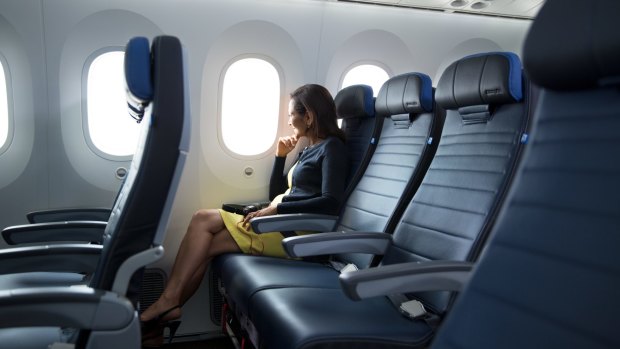
In some cases they're flying aircraft with almost as many of these upgraded economy seats as standard economy seats on their aircraft. On its widebody aircraft, United is offering anything from one third to half as many economy plus seats as economy. Aboard some of its aircraft operating on international routes United has more Economy Plus seats than standard economy. Latest airline to join the club is Etihad Airways which installed economy space seats on its A380s, with a generous seat pitch 12.7cm greater than in the airline's standard economy seats.
See also: Flight test: United Economy Plus
Virgin Australia hopped on board with its own economy X seats back in mid-2017. Aboard the airline's Boeing 777-300ER aircraft, used for some of its international flights, Virgin offers 75 economy X seats with a seat pitch of 96.5cm, the same as Qantas' premium economy seats, and just 7.6cm less than Virgin's own premium economy seats aboard the same aircraft.
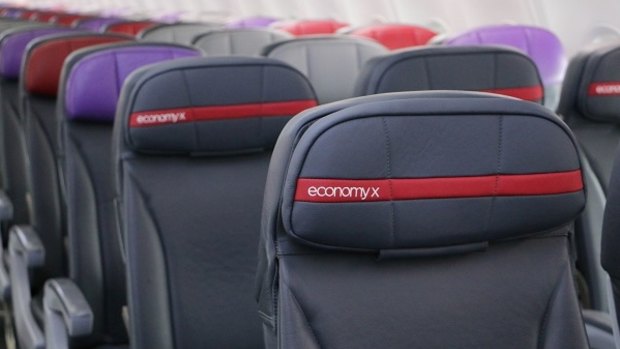
Both from a passenger's perspective and the airline's, this class is a no-brainer. For a return economy flight from Melbourne to Los Angeles in June, United fares start at $1135 in economy. If you select economy plus seating, that adds $276 to the total fare. By increasing seat pitch for economy plus flyers by 7.6cm, United is sacrificing 10 per cent of its seats, but United's gain in revenue on that particular fare is much greater – about 24 per cent.
See also: Airline review: Is Virgin's 'Economy X' class worth the extra $149?
In the case of Virgin Australia's economy X seat, since the pitch is greater than United's the airline is losing more real estate over a standard economy seating – close to 19 per cent. A return economy flight with Virgin from Sydney to Los Angeles in October is currently available at $1312. Select economy X seating and you'll pay another $400. That's a revenue gain of 30 per cent on that fare, and a big win for the airline. Why more airlines aren't embracing economy plus is a mystery.
See also: Airlines are adding a new type of economy class to planes
See also: Is flying premium economy worth it?
Sign up for the Traveller newsletter
The latest travel news, tips and inspiration delivered to your inbox. Sign up now.